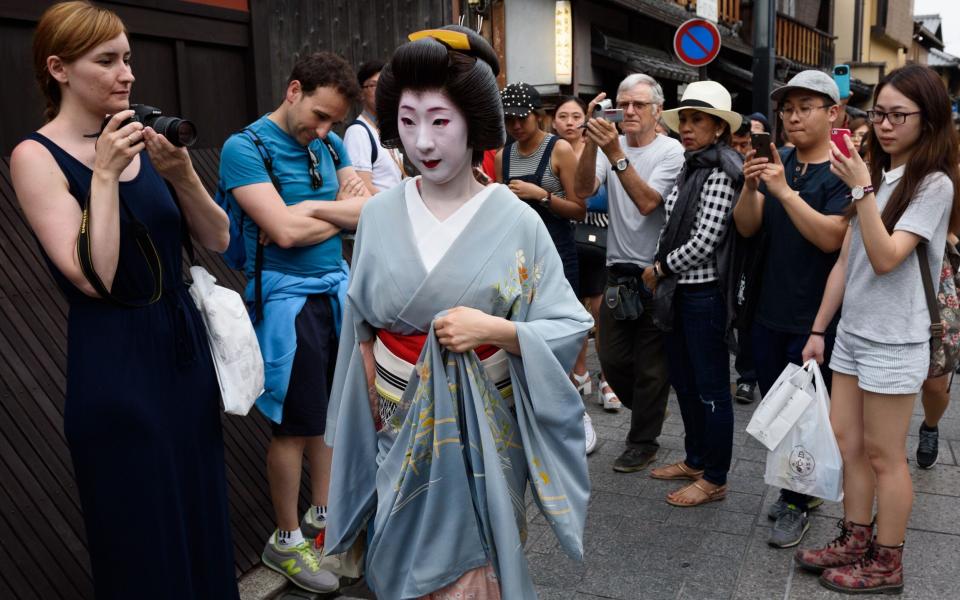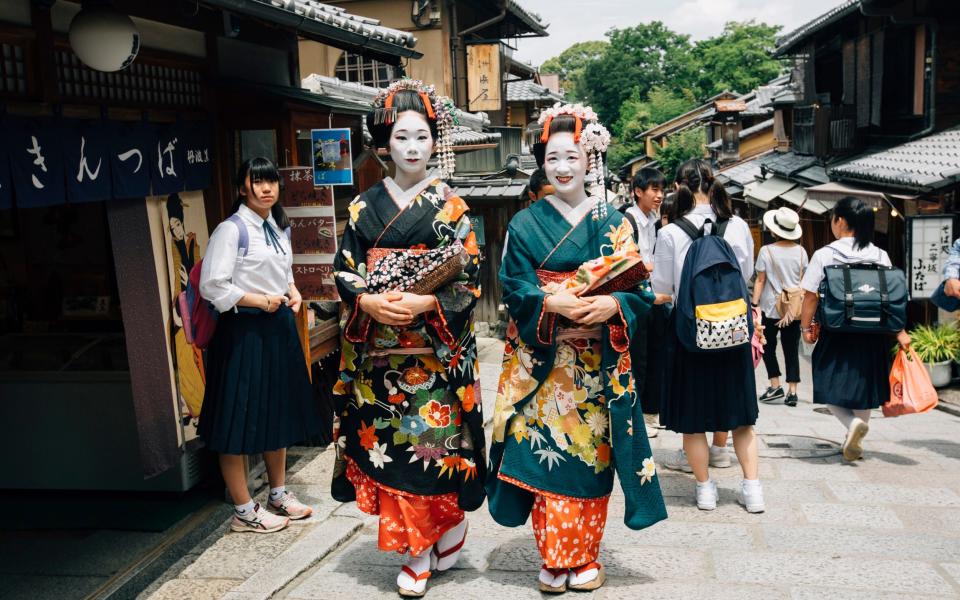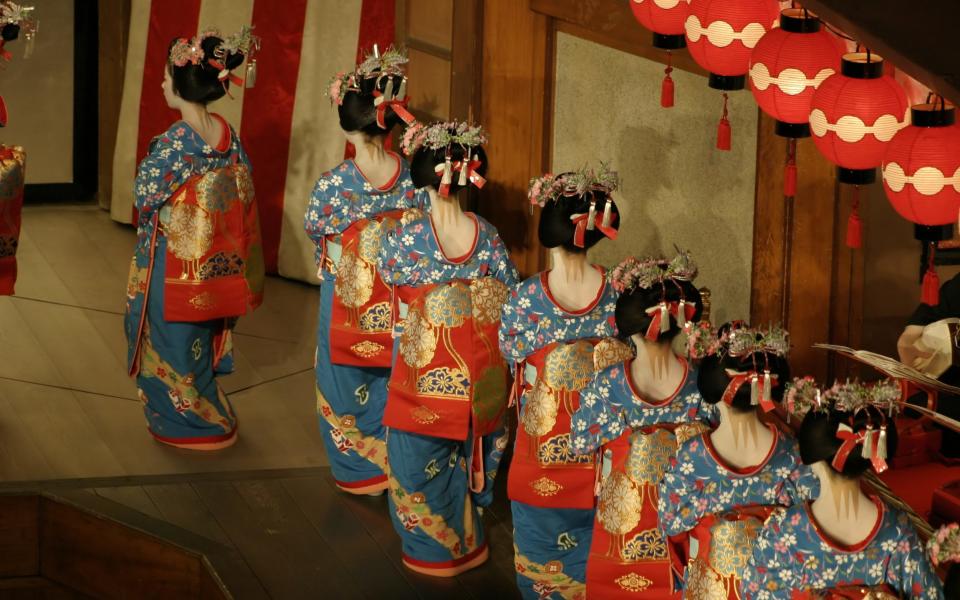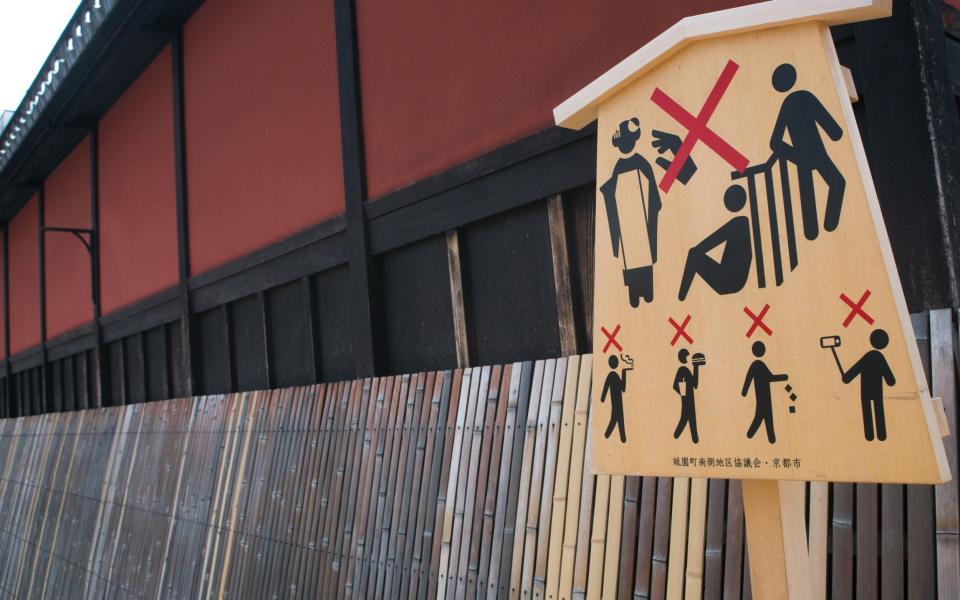How to see geisha in Japan – and how to behave

A swish of silk kimono. The clip of wooden shoes on cobblestones. A flash of scarlet lips on a white painted face.
For many visitors to Kyoto, capturing a dream-like glimpse of a geisha is something of a holy grail. Steeped in ritual and layered in beauty, a geisha is one of Japan’s most poetic expressions of its traditional cultural heritage.
Yet Kyoto’s so-called world of flowers and willows has long been as blink-and-you-miss it elusive as it is seductive, particularly to tourists – and it will soon become harder than ever to witness.
This week, officials in Kyoto’s historic geisha district Gion announced plans to limit access to its atmospheric centuries-old network of back streets, lined with time-capsule teahouses and wooden dwellings, in a bid to curb a sharp surge in post-pandemic tourism.
The move follows a catalogue of complaints from locals, with issues ranging from tourists chasing geisha down streets in order to take photographs to one having her kimono torn and another reportedly having a cigarette stubbed out on her collar.
While some of these incidents are extreme, the overcrowding of Gion’s scenic backstreets is clearly a growing issue, deeply at odds with the rarefied and exclusive culture that has long defined the essence of the geisha world.

Many experts cite over-tourism as merely part of the problem – laying the greater blame on tourists’ general lack of awareness to the sensitively nuanced layers of Japanese culture.
As James Mundy, of specialist Japan tour operator InsideJapan Tours (insidejapantours.com), explains: “Kyoto is a beautiful place, and popular for good reason. And, to a degree, it’s understandable that crowds of tourists flock there, trying to get that perfect picture of a temple or that snap of a geisha. But this is about responsible tourism and cultural awareness, which some major tour companies and individuals simply aren’t interested in. They focus instead on getting that photo for their social media.
“Popular temples and shrines are part of daily life for locals, and at some of the more popular places, the throngs of tourists tend to get in the way. It is the interruption of everyday life – and more importantly, the lack of cultural respect and awareness – that angers some locals and has caused local authorities to take action.”
What is a geisha?
There is often a clouded understanding of what it means to be a geisha.
The centuries-old world of geisha – or geiko, as they are called in Kyoto – is a longstanding symbol of refinement, beauty and mastery of traditional arts.

Rigorously trained as apprentices (known as maiko) for years, they are deeply accomplished entertainers, who have mastered a medley of traditional Japanese art forms, from dancing and playing musical instruments to tea ceremony and the art of conversation.
The geisha world has long thrived in Kyoto in particular. The ancient city was the capital of Japan for more than 1,000 years, until the late 19th century, and was consequently the birthplace of countless iconic traditions. Like tea ceremonies, ikebana flower arranging and kimono textiles, the world of geisha is etched deeply into the fabric of Kyoto’s cultural DNA and local life.
As Mundy explains: “There are a lot of misconceptions about geisha. One is that they are prostitutes – which they are very much not. Geisha are respected, traditional hostesses, trained for many years in the performing arts, enabling them to provide an exclusive traditional entertainment service that includes dance, music, drinks, games and conversation. They are certainly not tourist sights, but rather custodians of a traditional culture.”
Where can you experience authentic geisha culture today?
While Gion is the most famed hub for geisha in Kyoto, it’s not the only place where tourists can experience a taste of this willows-and-flowers world.

Kyoto is home to five traditional geisha districts – known as Hanamachi, which translates as “flower town” – with many neighbourhoods offering a more low-key and local experience.
But wandering the streets of these districts clutching an iPhone in the hope of catching a glimpse of a geisha is not the best way to go about this. Not only does it contribute to issues of over-tourism and interfere with daily life, but it also rarely captures the beauty and essence of experiencing a geisha’s skills.
Instead, choose a respected tour operator or luxury hotel, many of which can arrange access to an authentic experience, by booking a tea ceremony or dinner in a private teahouse with a geiko.
For a more budget-conscious experience? Gion Corner also offers a programme of traditional performing arts and culture – with a one-hour showcase including a Kyoto dance by maikos as well as a tea ceremony, ikebana and kyogen comedy. Visitors can even have their photographs taken here with a maiko or geiko. Tickets are available online (kyoto-gioncorner.com) and via the Kyoto Tourist Information Centre Kyo Navi (kyoto.travel).

What rules and etiquette should you follow when meeting a geisha?
Guidelines drawn up by Kyoto City Tourism Association alongside Kyoto City in the Kyoto City Official Travel Guide are clear in their dos and don’ts. For example, visitors are urged to refrain from stopping, following or taking unauthorised photos or videos of geisha as they walk around.
A “Mind Your Manners” campaign is also promoted via posters across Kyoto City, with some more general advice including:
Move quietly when exploring residential areas or religious sites
Don’t follow the crowd
Leave your luggage behind
Don’t take photos where it is prohibited


